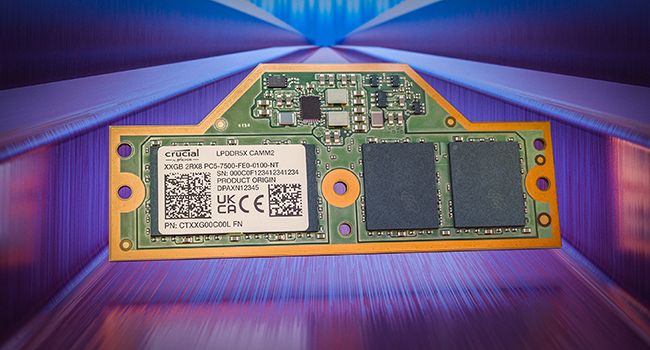
With the new low-profile CAMM2 memory standard now being adopted by laptop makers, Crucial has begun selling 32GB and 64GB LPCAMM2 modules for $179.99 and $329.99 respectively. These modules come with speedy LPDDR5X 7500MHz ICs and are designed to be replacements or memory upgrades for systems that support Micron's LPCAMM2 memory.
LPCAMM2 is one of only a couple of brand-new memory modules utilizing the all-new CAMM2 JEDEC memory standard. CAMM2 is a new form factor for DDR5 that is 64% smaller than DDR5 SO-DIMM memory. CAMM2 is so small thanks to its bandwidth capabilities, which allows just one module to fill the entire 128-bit memory bus of a CPU's memory controller. This allows just one module to achieve the same bandwidth as two DDR5 SO-DIMM modules operating in dual-channel mode.
CAMM2 can be utilized with either standard DDR5 ICs or faster LPDDR5X ICs. Micron has opted to go with the latter with its LPCAMM2 modules, which feature a 7500 MT/s rating that provides 1.3x more bandwidth compared to standard DDR5 (operating at JEDEC speeds). LPDDR5X also enables Micron's LPCAMM2 modules to have 43-58% lower active power consumption and up to a whopping 80% lower standby power.
At the moment, Micron's new memory is only supported on the Lenovo ThinkPad P1 Gen 7, the first and currently only computing device on the market right now that uses CAMM2-style memory. As a result, Crucial's new modules will only be beneficial for ThinkPad P1 Gen 7 users who want to upgrade to 64GB of memory.
However, CAMM2's immense size, performance, and power efficiency improvements are impossible to ignore. We fully expect other device manufacturers and even desktop motherboard makers to begin adopting the standard shortly.
Both the 32GB and 64GB versions of the modules sport 16GB LPDDR5X dies operating at 1.05v at 7500 MHz. Crucial is only selling each capacity in single module formats since there is no need for dual-channel kits with CAMM2 memory.
$179.99 and $329.99 might be really expensive for what is effectively high-clocked DDR5 memory, but that is the price you pay for bleeding-edge technology. Once CAMM2 goes mainstream, we can expect pricing to start dropping, similar to how DDR5 memory prices dropped after the Ryzen 7000 series launch made DDR5 popular in the desktop space.







